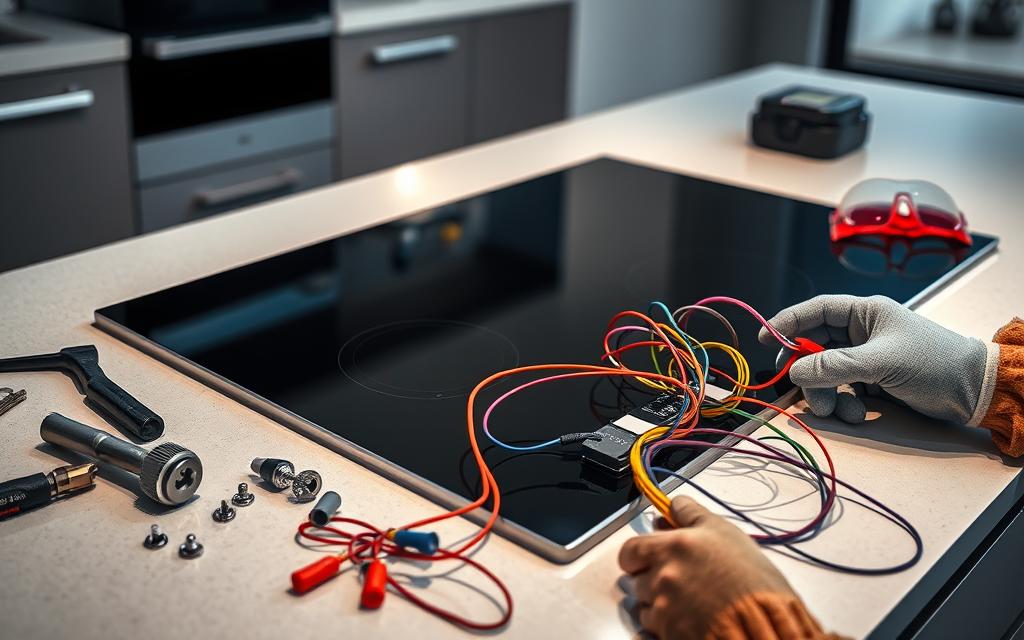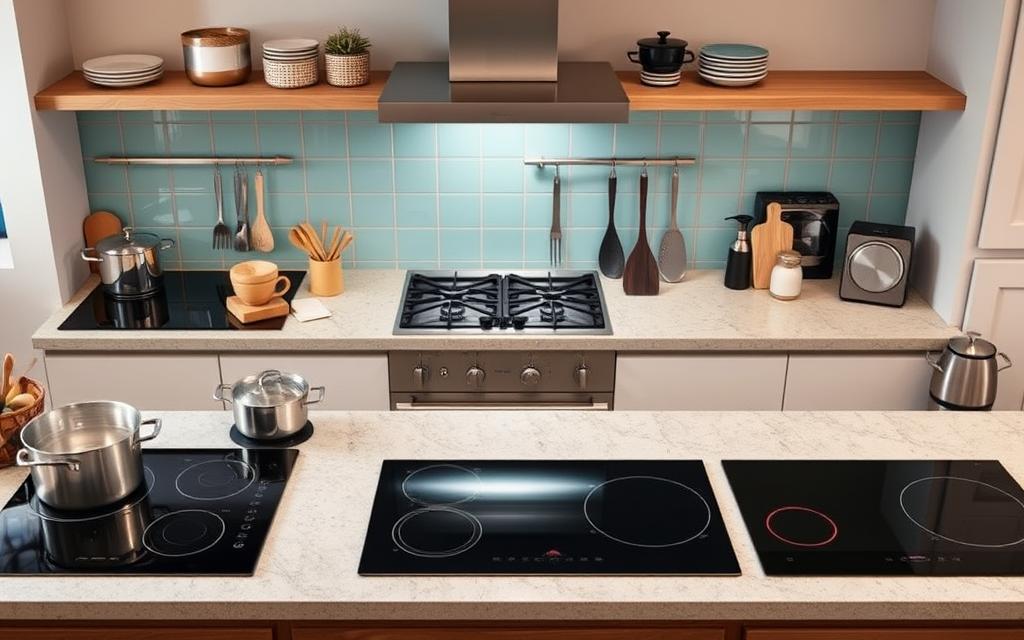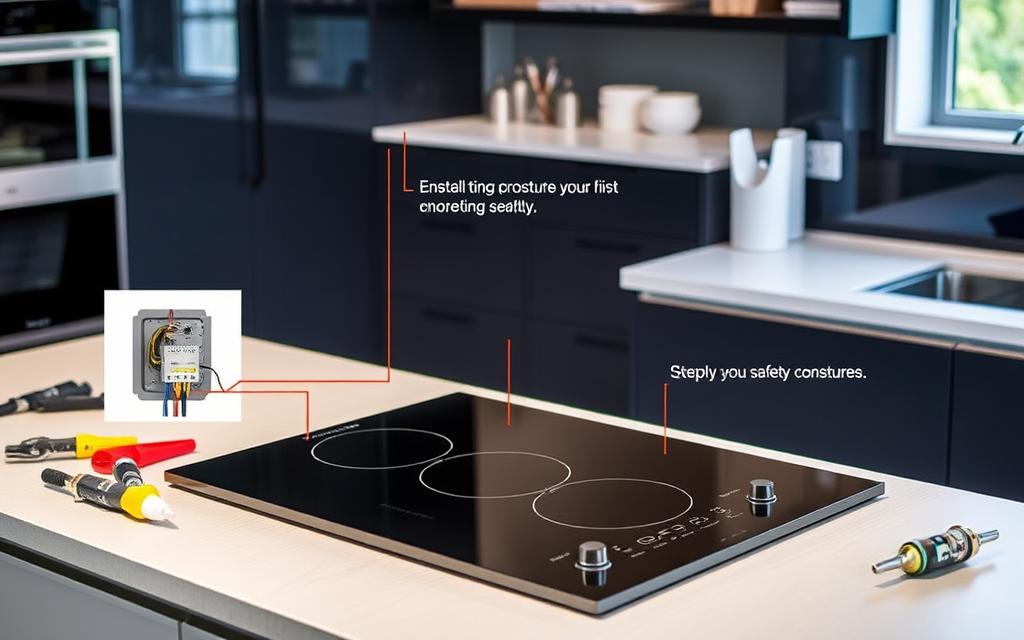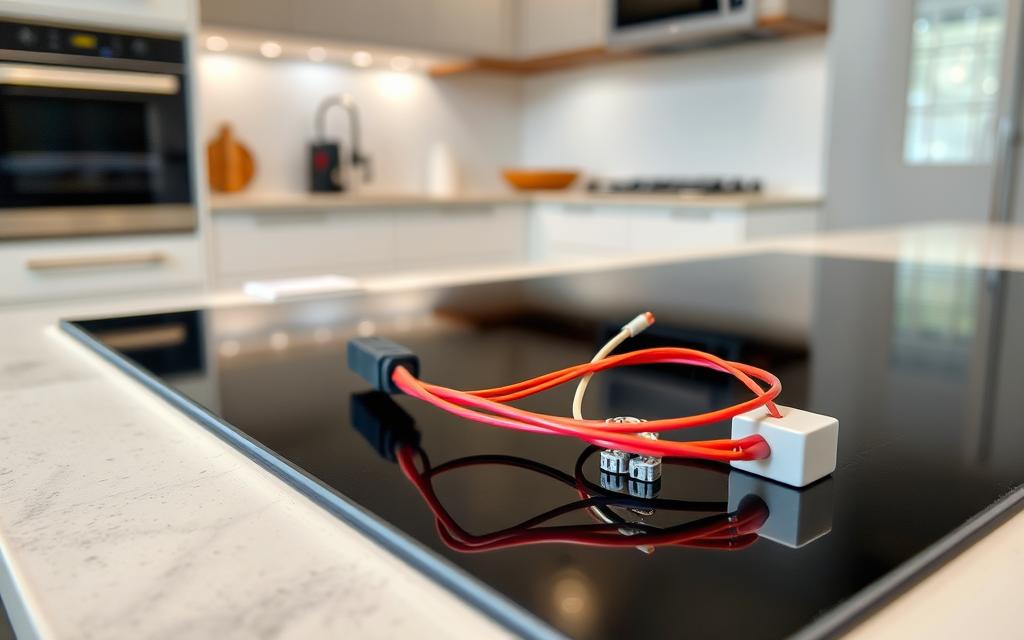Understanding how to install an electric cooktop can transform your kitchen for the better. It’s one of the easiest cooking appliances to set up, but it requires careful planning and attention to detail.
Electric cooktops let you control the temperature precisely. They can make cooking up to 25% more efficient. The cost to install one ranges from $70 to $155, plus extra for wiring.
Installing an electric cooktop is more than just mounting it. You need to make sure the electrical connections are right. This includes dedicated circuits and the right voltage for safety and function.
Key Takeaways
- Electric cooktop installation requires careful planning and precision
- Proper electrical connections are crucial for safety and performance
- Dedicated 240-volt circuits are typically required
- Professional installation helps prevent potential electrical issues
- Understanding local building codes is essential
Essential Pre-Installation Planning and Requirements
Getting ready for an electric cooktop installation needs careful planning. Knowing what you need is key for a safe and successful setup. Before starting, make sure you have all the right info and tools.
There are important steps to take to avoid common problems. Knowing the electric cooktop’s size is crucial for fitting it right in your kitchen.
Required Tools and Materials
- Measuring tape
- Electric drill
- Screwdriver set
- Level
- Electrical circuit tester
- Safety gloves
- Protective eyewear
Safety Precautions and Guidelines
When installing an electric cooktop, safety comes first. Electrical work can be risky, so be careful:
- Turn off power at the circuit breaker
- Check the electrical circuit specs
- Wear the right safety gear
- Follow local building codes
- Think about getting a pro if you’re not sure
“Proper preparation prevents poor performance.” – Kitchen Installation Professionals
Measuring and Space Requirements
Getting your measurements right is key for electric cooktop installation. If space is tight, consider a portable electric stove top.
| Cooktop Type | Typical Width | Recommended Clearance |
|---|---|---|
| Standard Electric | 30 inches | 30 inches above, 1 foot on sides |
| Wide Electric | 36 inches | 36 inches above, 1-2 feet on sides |
| Portable Electric | 24 inches | Flexible placement |
Don’t forget to subtract ½-1 inch from each side for the cooktop’s lip. This ensures a perfect fit and a professional look.
Understanding Different Types of Electric Cooktops
Choosing the best electric cooktop for your kitchen means looking at several exciting options. Each type offers unique features and benefits to change how you cook.
Today’s electric cooktops offer versatile solutions that mix technology with practicality. Your choice will depend on your cooking style, kitchen design, and what you like.
Radiant Electric Cooktops
Radiant electric cooktops have smooth glass surfaces with heating elements below. They come with:
- Flat, easy-to-clean surface
- Consistent heat distribution
- Sleek, modern appearance
- Affordable pricing range
Induction Cooktops
Induction cooktops are the latest in electric cooktop technology. They use magnetic heating for:
- Faster cooking times
- Precise temperature control
- Energy-efficient performance
- Cool-to-touch surface
“Induction cooktops revolutionize kitchen cooking with their intelligent heat technology.” – Culinary Expert
Smooth-Top Electric Cooktops
Smooth-top electric cooktops blend beauty with cooking performance. They are among the top choices for modern kitchens.
- Seamless glass surface
- Multiple burner configurations
- Easy maintenance
- Contemporary design
Choosing the right electric cooktop depends on your cooking needs, kitchen layout, and budget.
How to Install Electric Cooktop
Installing an electric cooktop needs careful planning and precision. Your electric cooktop installation guide starts with understanding the key steps. These steps ensure a safe and efficient setup. Before starting, gather all necessary tools and review the manufacturer’s specific instructions.
“Proper installation is key to the performance and safety of your electric cooktop.” – Kitchen Appliance Safety Association
Here’s a detailed step-by-step guide for installing an electric stove in your kitchen:
- Shut Off Power: Always disconnect electricity at the circuit breaker to prevent electrical hazards
- Verify Countertop Cutout: Measure existing cutout to match new cooktop dimensions precisely
- Prepare Installation Area: Clean the countertop surface thoroughly
- Position Cooktop: Carefully lower the appliance into the prepared cutout
- Connect Electrical Wiring: Match wire colors and secure connections with wire nuts
- Secure Mounting: Use provided brackets to fasten cooktop to countertop
Important installation considerations include maintaining minimum clearances. Ensure at least 2 inches of space from combustible materials. Also, verify your electrical circuit meets the specific amperage requirements for your cooktop model.
Pro tip: Apply RTV sealant around the cooktop’s edges for a waterproof seal. Remember that the sealant fully cures after 24 hours, so avoid using the cooktop during this time.
While many homeowners can complete this installation, don’t hesitate to consult a professional electrician. This is if you encounter complex wiring or are unsure about any step in the process.
Electrical Requirements and Wiring Connections
Installing an electric cooktop needs careful electrical work for safety and efficiency. Knowing the electrical needs is key for a good install.
Before installing an electric cooktop, you must follow certain electrical standards. These ensure the cooktop works well and safely.
Power Supply Specifications
Electric cooktops need specific power details for best performance and safety. Most require a 240-volt circuit with certain amperage levels.
- Typical circuit breaker rating: 50 amps
- Wire gauge: #6 for standard electric ranges
- Voltage requirement: 120/240-volt circuit
Circuit and Voltage Requirements
Your electrical setup for installing an electric stove must meet NEC standards. Since 1996, all new setups need a 4-wire connection.
| Circuit Type | Wire Configuration | Typical Use |
|---|---|---|
| Standard Range | 4-wire (2 hot, 1 neutral, 1 ground) | Full-size electric cooktops |
| Smaller Range | 40-amp circuit | Ranges under 12,000 watts |
Proper Grounding Techniques
“Proper grounding is not optional—it’s a critical safety requirement for any electrical appliance installation.”
Grounding your electric cooktop is essential for safety. Here are some steps to follow:
- Use green or green-striped insulation for ground wires
- Ensure equipment grounding conductor is identifiable
- Follow NEC guidelines for wire re-identification
While you can try to install it yourself, hiring a pro is safer and more reliable for complex wiring.
Ventilation and Countertop Considerations
When you install an electric cooktop, ventilation and countertop choice are key. They affect both how well it works and how it looks in your kitchen. Each electric cooktop brand has its own needs for installation and air flow.
Ventilation is vital for keeping your kitchen air clean. Your cooking style and the size of your electric cooktop will guide you to the best ventilation system. You have many choices to manage smoke and heat:
- Range hoods
- Downdraft ventilation systems
- Under-cabinet exhaust fans
- Ceiling-mounted ventilation units
“Proper ventilation not only improves air quality but also extends the life of your electric cooktop and kitchen surfaces.” – Kitchen Design Experts
Choosing the right countertop material is also crucial for electric cooktops. Think about these points:
- Heat resistance
- Durability
- Aesthetic compatibility
- Maintenance requirements
Different electric cooktop brands suggest specific countertop materials. This ensures your cooktop works well and lasts long.
| Countertop Material | Heat Resistance | Maintenance Level |
|---|---|---|
| Granite | High | Medium |
| Quartz | Medium-High | Low |
| Ceramic | High | High |
When planning your electric cooktop installation, remember that about 30% of homeowners forget to measure cutout sizes. This can cause big installation problems. Talking to experts and following manufacturer guidelines will help you avoid these issues.
Conclusion
Installing an electric cooktop needs careful planning and attention to detail. Prices vary from $200 to $1,500. This means you can find a model that fits your budget and kitchen needs. Knowing the electric cooktop features helps you make a smart choice for your kitchen upgrade.
Safety is key during installation. About 70% of DIY electrical work can be dangerous. Always follow the manufacturer’s instructions closely. Whether it’s a traditional, induction, or ceramic cooktop, proper installation is crucial. It ensures the cooktop works well and avoids electrical issues.
If you’re not comfortable with electrical work, consider hiring a pro. Installation costs range from $250 for simple setups to $800 for complex ones. By understanding your cooktop’s needs and possibly getting expert help, you’ll have a safe and efficient cooking space. This will also improve your kitchen’s functionality.
Your new electric cooktop is more than just an appliance. It’s an investment in your home’s cooking abilities. Spend time researching, planning, and installing it carefully. This way, you’ll enjoy reliable and enjoyable cooking for years to come.
FAQs:
Q1: What tools do I need to install an electric cooktop?
A: You’ll need a screwdriver, wire stripper, and a voltage tester. Also, a measuring tape, level, and electrical tape are important. Don’t forget an adjustable wrench, sealant, and protective gloves. Always check the manufacturer’s guide for exact tools needed.
Q2: How do I know if my kitchen’s electrical system can support an electric cooktop?
A: Look at your home’s electrical panel for a 240-volt circuit. It should have 40-50 amps for most cooktops. It’s best to have a licensed electrician check your system before you start.
Q3: What are the standard dimensions for electric cooktops?
A: Electric cooktops usually are 20, 24, 30, or 36 inches wide. Make sure to measure your countertop carefully. Compare it with the cooktop model’s size to fit it right.
Q4: Are induction cooktops more expensive than traditional electric cooktops?
A: Yes, induction cooktops cost more at first because of their tech. But, they cook faster, use less energy, and are safer. This can make up for the higher price.
Q5: Can I install an electric cooktop myself, or should I hire a professional?
A: If you’re good with DIY, you might install it yourself. But, it’s safer to hire a licensed electrician. This is true if you’re not sure about the electrical parts or if local codes require a pro.
Q6: What safety precautions should I take during electric cooktop installation?
A: Always turn off the power at the breaker first. Use a voltage tester to make sure it’s off. Wear gloves and follow the manufacturer’s instructions carefully. Make sure the electrical connections are grounded properly.
Q7: How do I choose between a radiant, induction, or smooth-top electric cooktop?
A: Think about what you need to cook, your budget, and your kitchen’s style. Radiant cooktops are affordable, induction is precise, and smooth-top is easy to clean.
Q8: What electrical requirements are needed for a typical electric cooktop?
A: Most need a 240-volt circuit with a 40-50 amp breaker. This circuit should be just for the cooktop. Check your panel’s capacity and get help if you’re not sure.
Q9: How do I properly measure my countertop for an electric cooktop installation?
A: Measure the width, depth, and cutout size carefully. Leave enough space around the cooktop as the manufacturer suggests. Always check the guide for your model’s exact needs.
Q10: What maintenance is required after installing an electric cooktop?
A: Clean it regularly with the right products. Avoid harsh cleaners and check the connections yearly. Keep the surface clean to keep your cooktop working well for a long time.




Leave a Reply